
Another Edinburgh Castle
Edinburgh Castle in the centre of the capital is the most visited tourist attraction charging an entrance fee in the whole of Scotland - and justifiably so. But few of the million and more visitors to Edinburgh Castle know that, visible on the edge of the city, is another castle which is regarded as one of the of the most perfectly preserved late medieval castles in Scotland. Of course, with so many castles in the Scottish Borders and central Scotland having been attacked by invaders from the south, there are not that many well preserved castles in the first place!
There was a village at Craigmillar in the twelfth century and King David I granted land and houses there to Dunfermline Abbey. These days, although the castle stands on a hilltop surrounded by open fields, the Craigmillar suburb of Edinburgh is mainly local authority housing - a far cry from the days when the castle entertained royalty.
In the picture above, Edinburgh castle is seen on the horizon to the left.
The Owners of Craigmillar Castle
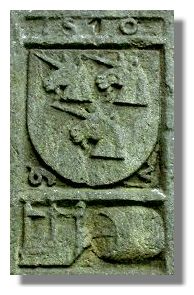 The building of the castle seems to have been started in the early 15th century after Sir John Preston had been granted a nearby barony at Gorton by King David II. Sir John's son was awarded the whole of the Craigmillar estate in 1374 by King Robert II - in return for providing an archer to serve in the monarch's army, whenever required.
The building of the castle seems to have been started in the early 15th century after Sir John Preston had been granted a nearby barony at Gorton by King David II. Sir John's son was awarded the whole of the Craigmillar estate in 1374 by King Robert II - in return for providing an archer to serve in the monarch's army, whenever required.
Succeeding generations of Prestons were important dignataries in Edinburgh, serving as sheriff of both Edinburgh and Berwick. In 1442, Sir William Preston gained considerable prestige by presenting to the city a reliquary containing an arm-bone of St Giles, the patron saint of the capital. When he died he was buried in St Giles' Kirk. The Preston arms can still be seen in Edinburgh's most important church building.
Over the centuries, the Prestons continued to expand and adapt Craigmillar - and entertain not only Mary Queen of Scots but other Scottish monarchs including King James VI. In 1511, King James IV granted a free barony of Craigmillar for which the rent was one penny Scots.
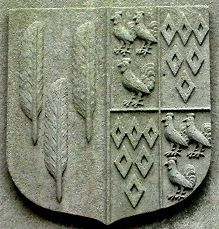 But by 1660, after the estate had passed to a distant relative, it was sold to Sir John Gilmour, an Edinburgh lawyer. In 1661 he became president of the Court of Session (the highest judicial court in Scotland) and he was also lord of the Exchequer.
But by 1660, after the estate had passed to a distant relative, it was sold to Sir John Gilmour, an Edinburgh lawyer. In 1661 he became president of the Court of Session (the highest judicial court in Scotland) and he was also lord of the Exchequer.
Sir John set about a major building programme in his new property. His son became Member of Parliament representing Midlothian, a post he held for 12 years. Both his son and grandson followed in his footsteps to Westminster. But during the 18th century the Gilmours moved to Insch House, near Gilmerton and Craigmillar castle became uninhabited. The romantic ruin later inspired the poet John Pinkerton to write "Craigmillar Castle: An Elegy." In 1946 the building was placed in State care and is now administered by Historic Scotland.
Mary Queen of Scots
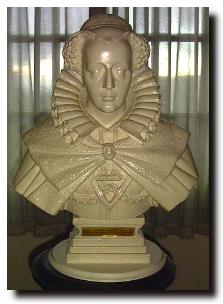 Sir Simon Preston assumed the baronetcy of Craigmillar in 1543 at a turbulent time in Scottish history. He had served as provost (mayor) of Edinburgh on two occasions and in addition to Craigmillar castle, he owned a town house on the Royal Mile in the capital. On the throne at that time was Mary Queen of Scots. She had inherited the throne when she was only six days old, after the death of her father, King James V, mortally wounded at the Battle of Solway Moss. The English King Henry VIII, seeing the opportunity to unite Scotland and England, negotiated the marriage of his son, Prince Edward, to Mary. When the Scots parliament refused to accept the agreement an English army landed at Leith and in the course of laying waste areas of southern Scotland to persuade the Scots to agree to the marriage, they captured Craigmillar castle.
Sir Simon Preston assumed the baronetcy of Craigmillar in 1543 at a turbulent time in Scottish history. He had served as provost (mayor) of Edinburgh on two occasions and in addition to Craigmillar castle, he owned a town house on the Royal Mile in the capital. On the throne at that time was Mary Queen of Scots. She had inherited the throne when she was only six days old, after the death of her father, King James V, mortally wounded at the Battle of Solway Moss. The English King Henry VIII, seeing the opportunity to unite Scotland and England, negotiated the marriage of his son, Prince Edward, to Mary. When the Scots parliament refused to accept the agreement an English army landed at Leith and in the course of laying waste areas of southern Scotland to persuade the Scots to agree to the marriage, they captured Craigmillar castle.
Mary had been sent to France for safety, and while there she married the heir to the French throne and eventually became Queen of France. However, her husband died within two years of becoming king and Mary returned to Scotland. It was a very different place from the one she had left. Although she was a devout Catholic, the majority of her subjects had converted to the Protestant faith. Mary frequently crossed swords with John Knox, the evangelical Protestant leader. But Sir Simon Preston became one of her staunchest supporters. She spent time at the castle and it was Sir Simon (once more provost of Edinburgh) who arrived at the Palace of Holyroodhouse with over 400 armed men after the murder of the queen's secretary and confidant, David Riccio.
Mary spent time at Craigmillar after the birth of her son (who later became King James VI) at Edinburgh castle. But the castle was later used to garrison troops led by the Regent Mar, who was beseiging Edinburgh castle. The fortification was held by Mary's supporters for a long time after her defeat at the Battle of Langside in 1568 and fleeing to England.
The Buildings
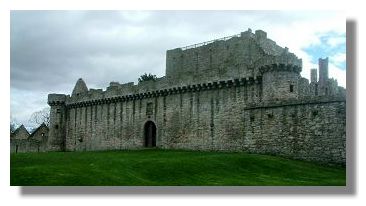 The castle began as a typical Scottish L-shaped tower house, dating from the early 15th century. There is a large hall on the second floor. At a later stage, a huge curtain wall was constructed, providing an outer defence against attack. There is a round-tower at each of the four corners. The parapet along the top of the wall projects outwards so that missiles or boiling water or tar could be dropped on any attackers attempting to breach or scale the wall.
The castle began as a typical Scottish L-shaped tower house, dating from the early 15th century. There is a large hall on the second floor. At a later stage, a huge curtain wall was constructed, providing an outer defence against attack. There is a round-tower at each of the four corners. The parapet along the top of the wall projects outwards so that missiles or boiling water or tar could be dropped on any attackers attempting to breach or scale the wall.
In the 16th century the building was enlarged with the reconstruction of of an earlier building on the east side of the castle, within the curtain wall. This provided more commodious accommodation for the Preston family than would have been possible in the tower house. It would be in this east range that Mary Queen of Scots would have stayed in 1563 and again in 1566. Beyond the east range was a chapel and and a walled garden.
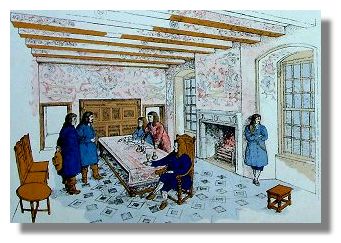 It was in the middle of the 17th century that Sir John Gilmour built a two-storey range to the west and this became the main focus of the castle. The need for a purely defensive castle was receding and this building has windows looking out over a formal sunken garden with a fish pond - shaped like the letter "P" for Preston.
It was in the middle of the 17th century that Sir John Gilmour built a two-storey range to the west and this became the main focus of the castle. The need for a purely defensive castle was receding and this building has windows looking out over a formal sunken garden with a fish pond - shaped like the letter "P" for Preston.
The good state of preservation of the castle means that today visitors can explore much of the castle and its many rooms and climb to the top of the tower house and admire the view towards Edinburgh and Arthur's Seat.
How to Get There
From the centre of Edinburgh, head south to the A7 and the Dalkeith Road (passing through the roundabout at Cameron Toll Shopping Centre). Continue along the A7, Old Dalkeith Road and the sign-post to the castle is on the left-hand side, just before the new Edinburgh Royal Infirmary complex at Little France.
See also the Location Map (you can enlarge/reduce the scale of this map, if required).



